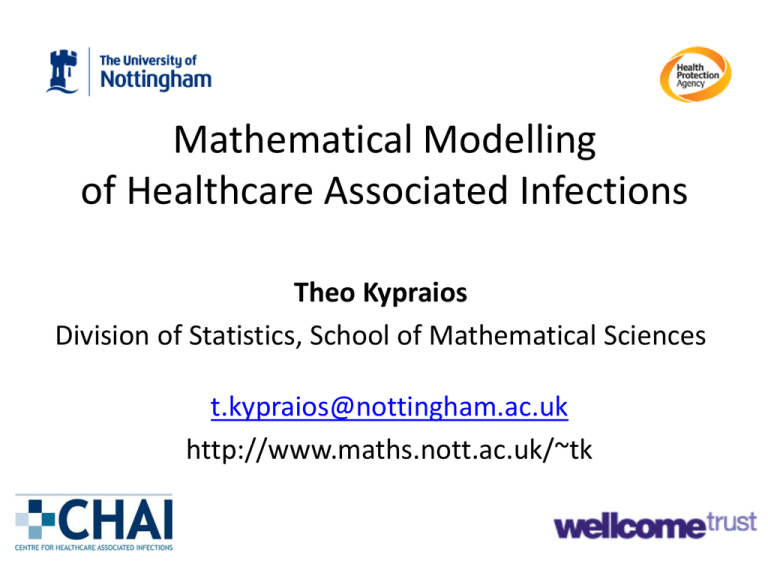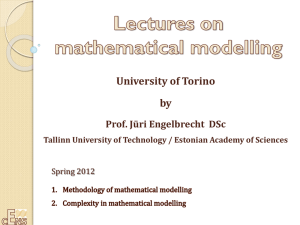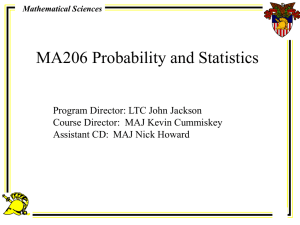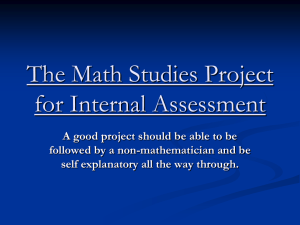Mathematical modelling - School of Mathematical Sciences
advertisement

Mathematical Modelling of Healthcare Associated Infections Theo Kypraios Division of Statistics, School of Mathematical Sciences t.kypraios@nottingham.ac.uk http://www.maths.nott.ac.uk/~tk Outline 1. Overview. 2. Mathematical modelling. 3. Concluding comments . Outline 1. Overview. 2. Mathematical modelling. 3. Concluding comments . Motivation • High-profile hospital-acquired infections such as: • Methicillin-Resistant Staphylococcus Aureus (MRSA) • Vancomycin-Resistant Enterococcal (VRE) have a major impact on healthcare within the UK and elsewhere. • Despite enormous research attention, many basic questions concerning the spread of such pathogens remain unanswered. Can we fill in the gaps? Aim: To address a range of scientific questions via analyses of detailed data sets taken from hospital wards. Methods: Use appropriate state-of-the-art modelling and statistical techniques. What sort of questions? • What value do specific control measures have? • isolation, handwashing etc. • Is it of material benefit to increase or decrease the frequency of swab tests? • What enables some strains to spread more rapidly than others? • What effects do different antibiotics play? What do we mean by ‘datasets’ ? Information on: • Dates of patient admission and discharge. • Dates when swab tests are taken and their outcomes. • Patient location (e.g. in isolation). • Details of antibiotics administered to patients. Outline 1. Overview. 2. Mathematical modelling. 3. Concluding comments . Mathematical Modelling – what is it? • An attempt to describe the spread of the pathogen between individuals. • Includes inherent stochasticity (= randomness). • Data enables estimation of model parameters. Mathematical Modelling: Simple Example • Consider population of individuals. • Each can be classified “healthy” or “colonised” each day. • Each colonised individual can transmit pathogen to each healthy individual with probability p per day. Mathematical Modelling: Simple Example Healthy person Colonised person Day 1 Daily transmission probability p = 0.5 Mathematical Modelling: Simple Example Healthy person Colonised person Day 2 Daily transmission probability p = 0.5 Mathematical Modelling: Simple Example Healthy person Colonised person Day 3 Daily transmission probability p = 0.5 Mathematical Modelling: Simple Example Healthy person Colonised person Day 4 Daily transmission probability p = 0.5 Mathematical Modelling: Simple Example Healthy person Colonised person Day 5 Daily transmission probability p = 0.5 Mathematical Modelling: Simple Example Healthy person Colonised person Day 6 Daily transmission probability p = 0.5 Mathematical Modelling: Simple Example 3 2 Cases 1 Plot of new cases per day 0 Day 1 Day 2 Day 3 Day 4 Day 5 Day 6 Mathematical Modelling: Inference Information about p could take various forms: • Most likely value of p • e.g. “p = 0.42” • Range of likely values of p • e.g. “p is 95% likely to be in the range 0.23 – 0.72” • In general, how p relates to any other model parameters? Mathematical Modelling In practice, we deal with more complicated models. • – The actual process is rarely fully observed . • – • i.e. more realistic models, more parameters. difficult to observe colonisation times. Inference becomes much more challenging. Mathematical Modelling How do we address hypotheses? e.g. Does transmission probability p vary between individuals? • Construct two models: one with same p for all, one where each individual has their own “p”. • Can determine which model best fits the data. Outline 1. Overview. 2. Mathematical modelling. 3. Concluding comments . Conclusions • Models seek to describe process of actual transmission and are biologically meaningful . • Scientific hypotheses can be quantitatively assessed . • Methods are very flexible but still contain implementation challenges. Thank you for your attention! Any questions?






